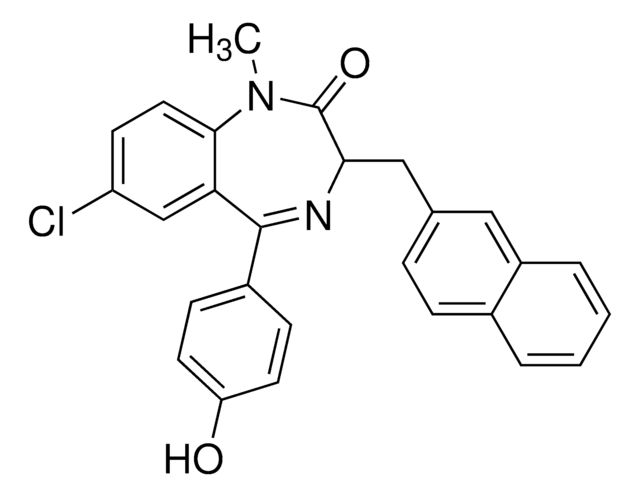If this product has an expiration or retest date, it will be shown on the Certificate of Analysis (COA, CofA). If there is no retest or expiration date listed on the product's COA, we do not have suitable stability data to determine a shelf life. For these products, the only date on the COA will be the release date; a retest, expiration, or use-by-date will not be displayed.
For all products, we recommend handling per defined conditions as printed in our product literature and website product descriptions. We recommend that products should be routinely inspected by customers to ensure they perform as expected.
For products without retest or expiration dates, our standard warranty of 1 year from the date of shipment is applicable.
For more information, please refer to the Product Dating Information document: https://www.sigmaaldrich.com/deepweb/assets/sigmaaldrich/marketing/global/documents/449/386/product-dating-information-mk.pdf
75351
Oligomycin A
≥99% (HPLC)
Synonym(s):
MCH 32
Select a Size
About This Item
Recommended Products
Quality Level
Assay
≥99% (HPLC)
form
powder
color
white to off-white
solubility
DMSO: soluble
antibiotic activity spectrum
fungi
Mode of action
enzyme | inhibits
storage temp.
−20°C
SMILES string
CCC1CCC2OC3(CC[C@@H](C)C(C[C@H](C)O)O3)[C@H](C)C(OC(=O)\C=C\[C@@H](C)[C@H](O)[C@@H](C)C(=O)[C@H](C)[C@@H](O)[C@H](C)C(=O)[C@@](C)(O)[C@H](O)[C@@H](C)C\C=C\C=C\1)[C@H]2C
InChI
1S/C45H74O11/c1-12-34-17-15-13-14-16-27(4)42(51)44(11,53)43(52)32(9)40(50)31(8)39(49)30(7)38(48)26(3)18-21-37(47)54-41-29(6)35(20-19-34)55-45(33(41)10)23-22-25(2)36(56-45)24-28(5)46/h13-15,17-18,21,25-36,38,40-42,46,48,50-51,53H,12,16,19-20,22-24H2,1-11H3/b14-13+,17-15+,21-18+/t25-,26-,27+,28+,29+,30-,31+,32+,33-,34?,35?,36?,38+,40-,41?,42-,44+,45?/m1/s1
InChI key
MNULEGDCPYONBU-VVXVDZGXSA-N
Looking for similar products? Visit Product Comparison Guide
General description
Application
Biochem/physiol Actions
Packaging
Other Notes
Storage Class Code
11 - Combustible Solids
WGK
WGK 3
Flash Point(F)
Not applicable
Flash Point(C)
Not applicable
Personal Protective Equipment
Choose from one of the most recent versions:
Certificates of Analysis (COA)
Don't see the Right Version?
If you require a particular version, you can look up a specific certificate by the Lot or Batch number.
Already Own This Product?
Find documentation for the products that you have recently purchased in the Document Library.
Customers Also Viewed
-
How can I determine the shelf life / expiration / retest date of this product?
1 answer-
Helpful?
-
-
How is shipping temperature determined? And how is it related to the product storage temperature?
1 answer-
Products may be shipped at a different temperature than the recommended long-term storage temperature. If the product quality is sensitive to short-term exposure to conditions other than the recommended long-term storage, it will be shipped on wet or dry-ice. If the product quality is NOT affected by short-term exposure to conditions other than the recommended long-term storage, it will be shipped at ambient temperature. As shipping routes are configured for minimum transit times, shipping at ambient temperature helps control shipping costs for our customers. For more information, please refer to the Storage and Transport Conditions document: https://www.sigmaaldrich.com/deepweb/assets/sigmaaldrich/marketing/global/documents/316/622/storage-transport-conditions-mk.pdf
Helpful?
-
-
For how long does the product remain stable once dissolved, aliquoted and stored at -20°C?
1 answer-
Storage of stock solutions at -20°C is stable for 1 month.
Helpful?
-
-
Does this product contain thimerosal or any mercury-containing preservatives?
1 answer-
This is a pure product, not containing any preservative or thimerosal.
Helpful?
-
-
What's it's solubility in dmso
1 answer-
This product is not tested for solubility in DMSO, however other Oligomycin products have been found to be soluble at in DMSO at 50 mg/ml.
Helpful?
-
Active Filters
Our team of scientists has experience in all areas of research including Life Science, Material Science, Chemical Synthesis, Chromatography, Analytical and many others.
Contact Technical Service










